
Buildings on the Prinzipalmarkt (the main plaza in Münster). (746k)
From the Münster entry in Wikipedia:
Münster is an independent city in North Rhine-Westphalia, Germany. It is in the northern part of the state and is considered to be the cultural center of the Westphalia region. It is also capital of the local government region Münsterland. Münster was the location of the Anabaptist rebellion during the Protestant Reformation and the site of the signing of the Treaty of Westphalia ending the Thirty Years' War in 1648. Today it is known as the bicycle capital of Germany.
Münster gained the status of a Großstadt (major city) with more than 100,000 inhabitants in 1915. Currently there are 300,000 people living in the city, with about 55,500 students, only some of whom are recorded in the official population statistics as having their primary residence in Münster.
Early history:
In 793, Charlemagne sent out Ludger as a missionary to evangelize the Münsterland. In 797, Ludger founded a school that later became the Cathedral School. Gymnasium Paulinum traces its history back to the school. Ludger was ordained as the first bishop of Münster. The first cathedral was completed by 850. The combination of ford and crossroad, market place, episcopal administrative center, library and school, established Münster as an important center. In 1040, Heinrich III became the first king of Germany to visit Münster.
Middle Ages and early modern period:
In the Middle Ages, the Prince-Bishopric of Münster was a leading member of the Hanseatic League. In 1534, the Anabaptists led by John of Leiden, took power in the Münster Rebellion and founded a democratic proto-socialistic state. They claimed all property, burned all books except the Bible, and called it the "New Jerusalem". John of Leiden believed he would lead the elect from Münster to capture the entire world and purify it of evil with the sword in preparation for the Second Coming of Christ and the beginning of the Millennium. They went so far as to require all citizens to be naked as preparation for the Second Coming. However, the town was recaptured in 1535; the Anabaptists were tortured to death, their corpses were exhibited in metal baskets (often confused with cages), which can still be seen hanging from the Tower of St. Lambert's steeple.
Part of the signing of the Peace of Westphalia of 1648 was held in Münster. This ended the Thirty Years' War and the Eighty Years' War. It also guaranteed the future of the prince-bishop and the diocese; the area was to be exclusively Roman Catholic.
18th, 19th and early 20th centuries:
The last outstanding palace of the German baroque period was created according to plans by Johann Conrad Schlaun. The University of Münster (today called "Westfälische Wilhelms-Universität Münster", WWU) was established in 1780. Now a major European center for excellence in education and research with large faculties in the arts, humanities, theology, sciences, business and law. Currently there are about 40,000 undergraduate and postgraduate students enrolled. In 1802 Münster was conquered by Prussia during the Napoleonic Wars. It was also part of the Grand Duchy of Berg between 1806 and 1811 and the Lippe department of the First French Empire between 1811 and 1813, before returning to Prussian rule. It became the capital of the Prussian province of Westphalia. A century later in 1899 the city's harbor started operations when the city was linked to the Dortmund-Ems Canal.
World War II
In the 1940s the Bishop of Münster, Cardinal Clemens August Graf von Galen, was one of the most prominent critics of the Nazi government. In retaliation for his success (The New York Times described Bishop von Galen as "the most obstinate opponent of the National Socialist anti-Christian program"), Münster was heavily garrisoned during World War II, and five large complexes of barracks are still a feature of the city. Münster was the headquarters (Hauptsitz) for the 6th Military District (Wehrkreis) of the German Wehrmacht, under the command of Infantry General (General der Infanterie) Gerhard Glokke. Originally made up of Westphalia and the Rhineland, after the Battle of France it was expanded to include the Eupen - Malmedy district of Belgium. The headquarters controlled military operations in Münster, Essen, Düsseldorf, Wuppertal, Bielefeld, Coesfeld, Paderborn, Herford, Minden, Detmold, Lingen, Osnabrück, Recklinghausen, Gelsenkirchen, and Cologne. Münster was the home station for the VI and XXIII Infantry Corps (Armeekorps), as well as the XXXIII and LVI Panzerkorps. Münster was also the home of the 6th, 16th and 25th Panzer Division; the 16th Panzergrenadier Division; and the 6th, 26th, 69th, 86th, 106th, 126th, 196th, 199th, 211th, 227th, 253rd, 254th, 264th, 306th, 326th, 329th, 336th, 371st, 385th, and 716th Infantry Divisions (Infanterie-division).
A secondary target of the Oil Campaign of World War II, Münster was bombed on October 25, 1944 by 34 diverted B-24 Liberator bombers, during a mission to a nearby primary target, the Scholven/Bür synthetic oil plant at Gelsenkirchen. About 91% of the Old City and 63% of the entire city was destroyed by Allied air raids. The US 17th Airborne Division, employed in a standard infantry role and not in a parachute capacity, attacked Münster with the British 6th Guards Tank Brigade on 2 April 1945 in a ground assault and fought its way into the contested city center, which was cleared in urban combat on the following day.
In the 1950s the Old City was rebuilt to match its pre-war state, though many of the surrounding buildings were replaced with cheaper modern structures. It was also for several decades a garrison town for the British forces stationed in West Germany.
All pictures are © Dr. Günther Eichhorn, unless otherwise noted.


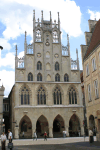

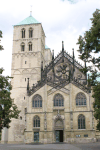
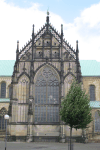

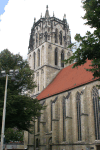
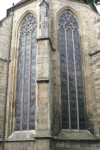
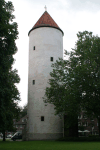
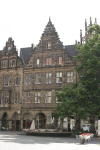


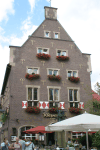
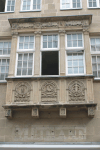
This page contains 15 pictures

Main page for Deutschland (Germany)
Page last updated on Tue Nov 2 15:41:51 2021 (Mountain Standard Time)